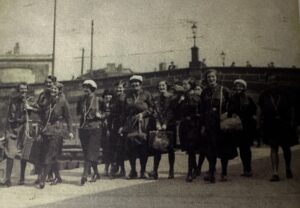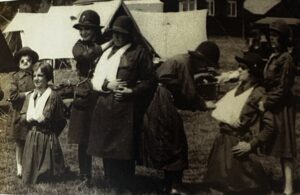OUR HISTORY
Scroll down to read the story of our county and our county commissioners!
Since those early days, the number of units in the county has grown from 1 to 135 and the number of people from 20 to nearly 2,500 (as of March 2023)!
Explore the rest of this page to discover more of our county history. This page has been based on a booklet produced by Mary York in 2009.

North Yorkshire South county members circa 1930
Our geographical area over time
A change in county boundaries in 1974 resulted in an increase in over 1000 members. In that year, Selby and Tadcaster came from Yorkshire West Riding county (the area that now consists of parts of Leeds, South Yorkshire and East Yorkshire counties). Along with this, Askham Bryan and Askham Richard came from the previous Leeds county.
Later on, Wilstrop district (which consisted of Tockwith and Long Marston) moved into the then Leeds county, with Camblesforth moving into Yorkshire East Riding county (now consisting of parts of East Yorkshire county).
From then on, our five divisions have formed part of North Yorkshire South county:
Abbey – named after Selby Abbey
Castle – named after Hazelwood Caste
Manor – named after the King’s Manor
Priory – named after Micklegate Priory (a monastery)
Tower – named after Clifford’s Tower
You can view our current county boundaries on our county map page.
Our significant change in numbers
Seebohm Rowntree noted that in 1935 Girlguiding membership in York (measured as a proportion of the population as part of th ‘Poverty and Progress’ report in 1941) was well above the national average.
The change in balance of numbers between different age groups is perhaps more significant than the actual numbers of members. In 1956 the number of Brownies over took the number of Guides for the first time.
Increases in the 1950s and 1960s were due to children from the post war ‘bulge’ joining the movement, aligned with the county boundary changes in 1974 onwards.
1989 was the first year that Rainbows were included in our county numbers.
Before World War II
Lillian Dickinson (1913-2005) was a Guides and Rangers leader and founder of both York and Acomb Trefoil Guilds, now known as York City and Priory guilds respectively. Lillian wrote about very interesting memories of the pre-war era:
“Every member wore black shoes and stockings when in unifrom. Our ties were folded triangular ones – yellow with two purple stripes; each guide matching her stripes in exactly the same position and we were all very proud of them. We all wore the guiding hat with the wide brim that had to be ironed each time using a damp rag and hot iron. We had a uniform inspection at every meeting.”
“We usually camped with St. Thomas’ company at Sweethill’s Farm. Tents would be erected and palliases filled with straw from the barn. Our sleeping bags were homemade consisting of a blanket with the backs of old woolly jumpers sewn inside. Camping was fun but hard work especially if it was raining as a wood fire was our only means of cooking. Drinking water was gotten from the farmyard pump and other water from the river some distance away. Campfire was always the highlight of camp!”
As the beginning of the war approached, they could sometimes hear noises from the army camp at Newton. Towards the end of the 1930s the Rangers and Rovers (a scouting section for adults) made up food parcels for families in need. In 1939 they used a derelict house in Swinegate, York, to store food and make up the parcels.
The war years
The war years brought great challenges as they did for every organisation in the country. Many volunteered or were drafterd into the forces or the Land Army. Many units (known as companies or packs back then) were run by senior Guides and Rangers, and at least one unit (company) was formed by a church member to provide activities for girls during the war.
The county report at the close of the war recorded that there were 36 Guides and Rangers in the women’s services, 30 doing civil defence work, 22 Guides had acted as messengers and 7 Guides helped in hospitals.
On 6th June 1954, Lady Baden-Powell visited a rally within York Museum Gardens, where York Guides won 2nd prize for a display during ‘Salute the Soldier’ week.
The image below shows some guides practising First Aid.
Our county commissioner history
From the very beginning Girlguiding has had a well defined and efficient network of administration, training and support. In all counties this network begins with the role of county commissioners.
This role has changed greatly over the past 100 years, with the county commissioner being a lady who was prominent in local affairs in the early days. This could include the wife of a Lord, Bishop or General. Most probably the first was the Honourable Irene Lawley, daughter of Lord Wenlock, in 1917-1919.
Next, in 1919-1922 came Lady Violet Maxse, the wife of General Maxse, Commander of the army’s Northern Command.
Irene Lawley, now known as Mrs Forbes-Adam and an important land owner, was reinstated as county commissioner and held the role until 1943 when she became county president.
Slightly more recently, Diana York of Hutton Hall held the role before becoming leader in charge of Waddow Hall in 1961. Norah Oldman, the wife of the Chief Education Officer was county commissioner from 1961 to 1971.
Joyce Clarkson was the first county commissioner in 1971 to be in paid employment at the same time as holding the role. Molly Stainthorpe took over in 1972 until 1981 and was responsible for the very efficient and successful reorganisation of the county to include Tadcaster and Selby at the same time local government areas were altered.
Barba Semmens had the inspiration behind the acquisition and adaption of White Rose House from a derelict village school to a pleasant holidy house and meeting centre, during her term of 1982-1988.
From there, Chris Bulmer (our current county president) was the driving force behind the planning and organising of the making of the new county standard during her term from 1988 to 1994, whilst Helen Porter instigated improvements in communication and paperwork across 1994-1999.
Anne Slade completed her term of office between 1999 – 2004 with a great day of celebration known as “Anne’s Dream” in Askham Bryan College grounds. For the first time, members from all sections were together to share a great variety of activities as well as raising £3000 for the Air Ambulance fund.
Joyce Green took over in 2004 until 2009, of which her term saw the update of White Rose House making sure that it complied with present government regulations.
Carole Wilson then took over as county commissioner in 2009 until 2014. The latter 4 county commissioners now make up our county vice-presidents, alongside Chris as president.
Since then, we have had Judith Bellamy from 2014 to 2019, with our current county commissioners, Alison & Lesley, being in post since 2019. Their term of office will end in October 2024.
The photo below shows Lesley (left) and Alison (second right), our current county commissioners, with Judith Bellamy (right) their predecessor at the Great Yorkshire Show 2022 with Jules Hudson (second left).

